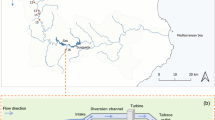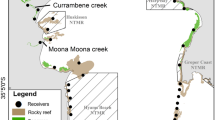Abstract
Information on a population of Abbottina rivularis inhabiting an agricultural ditch was collected during field surveys and was analyzed for age, growth, and habitat use. Measurements of 1,035 individuals revealed that the population had two size classes, a maturation age of 1 year, and a lifespan of 1–2 years. On the basis of the growth pattern and life stage, we classified the life cycle of this species into four stages: the juvenile stage, the immature stage with rapid growth and with no growth, and the adult stage. Habitat use during each stage was analyzed with a generalized linear mixed model. The best fit models revealed that 3–5 environmental factors were important predictors of population size in each stage. In particular, the number of fish increased with increased variation in water depth and with smaller median particle size of the bottom substratum in all stages.





Similar content being viewed by others

References
Akaike H (1974) A new look at the statistical model identification. IEEE Trans Automat Control 19:716–723
Amin S, Zafar MN, Halim A (2008) Age, growth, mortality and population structure of the oyster, Crassostrea madrasensis, in the Moheskhali Channel (southeastern coast of Bangladesh). J Appl Ichthyol 24:18–25
Azevedo JMN, Simas AMV (2000) Age and growth, reproduction and diet of a sublittoral population of the rock goby Gobius paganellus (Teleostei, Gobiidae). Hydrobiologia 400:129–135
Begon M, Harper JL, Townsend CR (1996) Ecology: individuals, populations and communities, 3rd edn, Japanese translation version. Kyoto Univ Press, Kyoto
Bolker BM, Brooks ME, Clark CJ, Geange SW, Poulsen JR, Stevens MHH, White JSS (2009) Generalized linear mixed models: a practical guide for ecology and evolution. Trends Ecol Evol 24:127–135
Fukuda S, De Baets B, Mouton AM, Waegeman W, Nakajima J, Mukai T, Hiramatsu K, Onikura N (2011) Effect of model formulation on the optimization of a genetic Takagi-Sugeno fuzzy system for fish habitat suitability evaluation. Ecol Model 222:1401–1413
Gayanilo FC, Sparre P, Pauly D (2005) FAO-ICLARM stock assessment tools II. Revised version. User’s guide. Worldfish Center, Rome
Hosoya K (2005) Abbottina rivularis. In: Kawanabe H, Mizuno N, Hosoya K (eds) Freshwater fishes of Japan, 3rd edn, Yama-Kei Publishers, Tokyo, pp 316–317
Ishikawa K, Azuma A (2005) Habitat factor of Japanese rice fish in paddy field area, focusing on the structure of irrigation and drainage canal. Assoc Rural Plan 7:19–24
Katano O, Hosoya K, Iguchi K, Yamaguchi M (2003) Species diversity and abundance of freshwater fishes in irrigation ditches around rice fields. Environ Biol Fish 66:107–121
Kyo K (2010) Bayesian statistical method for date analysis. Kyoritsu Shuppan Co, Ltd, Tokyo
Matsuzawa Y, Senou H (2008) Alien fishes of Japan. Bun-ichi Co, Ltd, Tokyo
Minagawa A, Takaki K, Coto M, Taruya H (2010) Migration and wintering of fish in irrigation channel in non-irrigation period. Trans JSIDRE 269:77–84
Ministry of the Environment (2003) Threatened wildlife of Japan: red data book, 2nd edn. Volume 4, Pisces: brackish and freshwater fishes. Japan Wildlife Research Center, Tokyo
Ministry of the Environment (2007) Red data book. Japan Integrated Biodiversity Information System. http://www.biodic.go.jp/rdb/rdb_top.html. Accessed 10 October 2012
Mizutani M (2007) An introduction to paddy field eco-engineering for sustaining and restoring biodiversity in rural areas. Rural Culture Association Japan, Tokyo
Nakabo T (ed) (2002) Fishes of Japan with pictorial keys to the species, English edn. Tokai University Press, Tokyo
Nakajima J, Nakagawa M (2007) Spawning season of the Chinese false gudgeon, Abbottina rivularis, in Katada Naiko, Lake Biwa. Humans and Nature 17:13–18
Nakajima J, Onikura N, Oikawa S (2008) Habitat of the pike gudgeon Pseudogobio esocinus esocinus in the Nakagawa River, northern Kyushu Island, Japan. Fish Sci 74:842–845
Nakamura M (1969) Cyprinid fishes of Japan—studies on the life history of cyprinid fishes of Japan. Research Institute for Natural Resources, Tokyo
National Institute for Environmental Studies, Japan (2012) The data base of invasive species. http://www.nies.go.jp/biodiversity/invasive/. Accessed 10 October 2012
Nikolsky GV (1963) The ecology of fishes. In translation by L. Birkett. Academic Press, London
Nykänen J, Huusko A (2003) Size-related changes in habitat selections by larval grayling (Thymallus thymallus L.). Ecol Freshw Fish 12:127–133
Onikura N, Nakajima J (2012a) Age, growth and habitat use of the topmouth gudgeon, Pseudorasbora parva in irrigation ditches on northwestern Kyushu Island, Japan. J Appl Ichthyol. doi:10.1111/j.1439-0426.2012.02041.x
Onikura N, Nakajima J (2012b) Koikagyorui no Seikatsushi: Gendai niokeru Kisaitekikenkyu no Igi. In: The Ecological Society of Japan (ed) Frontiers in freshwater ecology, Kyoritsu Shuppan Co, Ltd, Tokyo, pp 85–97
Onikura N, Nakajima J, Kouno H, Sugimoto Y, Kaneto J (2009) Habitat use in irrigation channels by the golden venus chub (Hemigrammocypris rasborella) at different growth stages. Zool Sci 26:375–381
Onikura N, Nakajima J, Kouno H, Sugimoto Y, Kaneto J (2010) Maturation and growth in the wild population of Hemigrammocypris rasborella. Aquac Sci 58:297–298
Onikura N, Nakajima J, Miyake T, Kawamura K, Fukuda S (2012) Predicting the distribution of seven bitterling species inhabiting northern Kyushu Island, Japan. Ichthyol Res 59:24–133
Pianka ER (1970) On r- and K-selection. Am Nat 104:592–597
Sagawa S, Kayaba Y, Arai H, Amano K (2005) Habitat selection by larval cyprinid fishes: relationship between larval habitats and experimental flooding. Ecol Civil Eng 7:129–138
Tang KL, Agnew MK, Chen W-J, Hirt MV, Raley ME, Sado T, Schneider LM, Yang L, Bart HL, He S, Liu H, Miya M, Saitoh K, Simons AM, Wood RM, Mayden RL (2011) Phylogeny of the gudgeons (Teleostei: Cyprinidae: Gobioninae) Mol Phylogenet Evol 61:103–124
Tsukahara H (1954) Breeding habits of the fresh-water sucker, Abbottina rivularis (BASILEESKY). Jpn J Ichthyol 3:139–143
Winemiller KO, Tarim S, Shormann D, Cotner JB (2000) Fish assemblage structure in relation to environmental variation among Brazos River oxbow lakes. Trans Am Fish Soc 129:451–468
Acknowledgments
The authors wish to thank Mr. T. Ihara, T. Kawamoto, A. Koyama, Y. Okamoto, H. Oura, and K. Ukai (Kyushu University) for their generous research support. Useful comments on the manuscript were provided by two anonymous reviewers. This study was supported in part by the Environment Research and Technology Development Fund (S-9) of the Ministry of the Environment, Japan. This study complies with current laws in Japan, and we paid attention to the “Guidelines for the use of fishes in research” published by the Ichthyological Society of Japan in 2003.
Author information
Authors and Affiliations
Corresponding author
About this article
Cite this article
Hayashi, K., Kim, E.J. & Onikura, N. Growth and habitat use of the Chinese false gudgeon, Abbottina rivularis, in an irrigation channel near the Ushizu River, northern Kyushu Island, Japan. Ichthyol Res 60, 218–226 (2013). https://doi.org/10.1007/s10228-013-0335-1
Received:
Revised:
Accepted:
Published:
Issue Date:
DOI: https://doi.org/10.1007/s10228-013-0335-1



